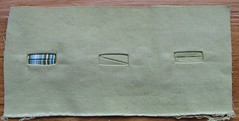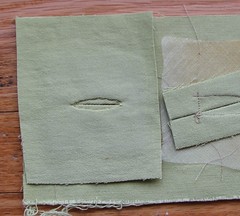This jacket might take me awhile. I’m going to use Vogue 8480. I started playing around with making bound buttonholes. I found a good method in Threads #95.
You make a faced window with organza (or a lining fabric). They recommend stitching over graph paper – this works really well for getting all the buttonholes the same size. I printed some with very small squares – 4/cm from here. Clip, turn the facing and then fuse the buttonhole lips in place with a bit of fusible web on the back side to hold them in place while you sew them down.
So easy and looks good. I’m excited. The method allows for different looking buttonholes (like the one in the middle) but I think I’ll just stick with the traditional one on the right.
 This is how the article recommends finishing the back. Pretty simple – cut a slit, fold back the edges and stitch it down by hand. I did this one after removing the basting threads holding the buttonhole lips together. It would be much easier if they were still basted together.
This is how the article recommends finishing the back. Pretty simple – cut a slit, fold back the edges and stitch it down by hand. I did this one after removing the basting threads holding the buttonhole lips together. It would be much easier if they were still basted together.
You make a faced window with organza (or a lining fabric). They recommend stitching over graph paper – this works really well for getting all the buttonholes the same size. I printed some with very small squares – 4/cm from here. Clip, turn the facing and then fuse the buttonhole lips in place with a bit of fusible web on the back side to hold them in place while you sew them down.
So easy and looks good. I’m excited. The method allows for different looking buttonholes (like the one in the middle) but I think I’ll just stick with the traditional one on the right.
 This is how the article recommends finishing the back. Pretty simple – cut a slit, fold back the edges and stitch it down by hand. I did this one after removing the basting threads holding the buttonhole lips together. It would be much easier if they were still basted together.
This is how the article recommends finishing the back. Pretty simple – cut a slit, fold back the edges and stitch it down by hand. I did this one after removing the basting threads holding the buttonhole lips together. It would be much easier if they were still basted together.
Thanks for the tip about the graph paper. Your buttonholes look great.
ReplyDelete